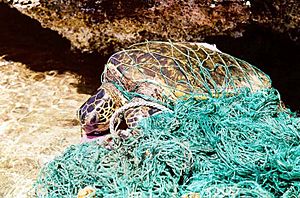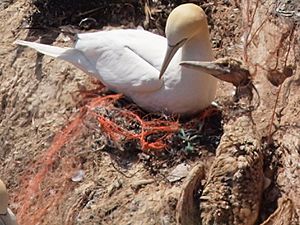Ghost net facts for kids

Ghost nets are fishing nets that have been lost or left behind by fishermen in the sea. These nets can float around for a very long time or get stuck on rocks and other things underwater. They are a big problem because they keep catching fish and other animals, even though no one is there to check them. The animals get trapped, can't move, and often starve or get hurt. Since most nets are made of plastic, they don't break down easily and can stay in the ocean for hundreds of years. As they slowly decay, they can also release harmful substances into the water.
Contents
What Are Ghost Nets?
Ghost nets are basically fishing nets that are no longer controlled by humans. They become "ghosts" because they continue to fish on their own. Fishermen might lose their nets during storms, or they might abandon them if they get snagged on something at the bottom of the ocean. Sometimes, nets are simply left behind if they are old or damaged. These lost nets can be very large, sometimes as big as a football field!
Why Are They a Big Problem for the Ocean?
Ghost nets are a serious threat to ocean life and the environment. Here's why:
- Trapping Animals: Many marine animals, like turtles, sharks, whales, dolphins, and seals, get caught in these nets. Once tangled, they can't swim freely to find food or reach the surface to breathe. This often leads to them starving, drowning, or getting severe injuries.
- Damaging Habitats: When ghost nets drift across the ocean floor, they can drag along and destroy important underwater habitats like coral reefs and sea grass beds. These places are vital homes and nurseries for many marine species.
- Plastic Pollution: Most fishing nets are made from strong plastics like nylon. These plastics break down very slowly, taking hundreds of years. As they break down, they turn into tiny pieces called microplastics. These microplastics can be eaten by small marine animals, which then enter the food chain, potentially affecting larger animals and even humans.
- Releasing Harmful Chemicals: Over time, the plastics in ghost nets can release toxic chemicals into the seawater. These chemicals can pollute the ocean and harm marine life.
What Can Be Done About Ghost Nets?
Dealing with ghost nets is a big challenge, but many groups and people are working to help:
- Retrieval Efforts: Divers and special teams go into the ocean to find and remove ghost nets. This is a dangerous job, but it saves many animals and cleans up the ocean.
- New Technologies: Scientists are developing new ways to track fishing gear so it doesn't get lost. They are also looking into making nets from materials that break down more easily or are easier to find if lost.
- Prevention: The best way to stop ghost nets is to prevent them from being lost in the first place. This means educating fishermen about responsible fishing practices and improving how nets are managed.
- Recycling: Some organizations collect old or retrieved fishing nets and recycle them into new products, like carpets, swimwear, or even skateboards. This helps reduce plastic waste and gives the nets a new purpose.
Images for kids
See also
 In Spanish: Red fantasma para niños
In Spanish: Red fantasma para niños




